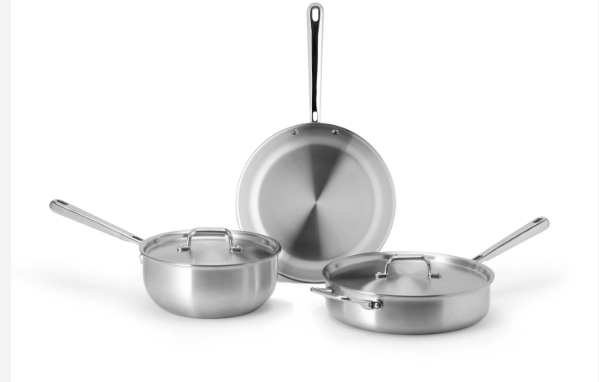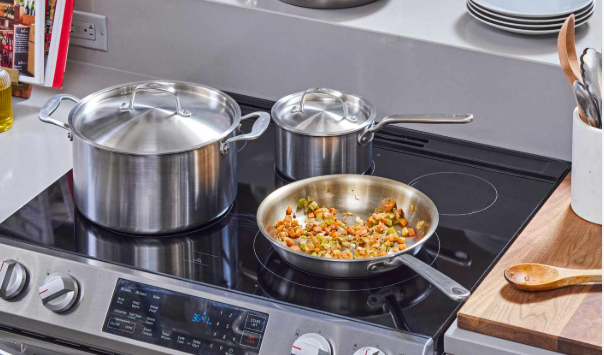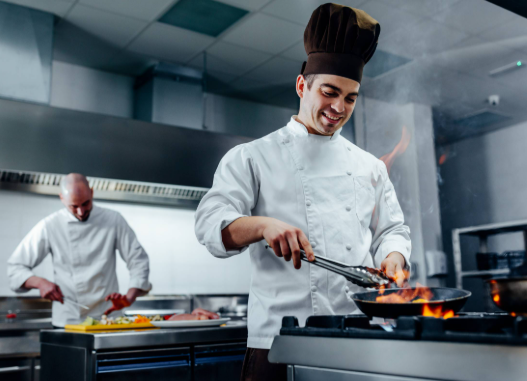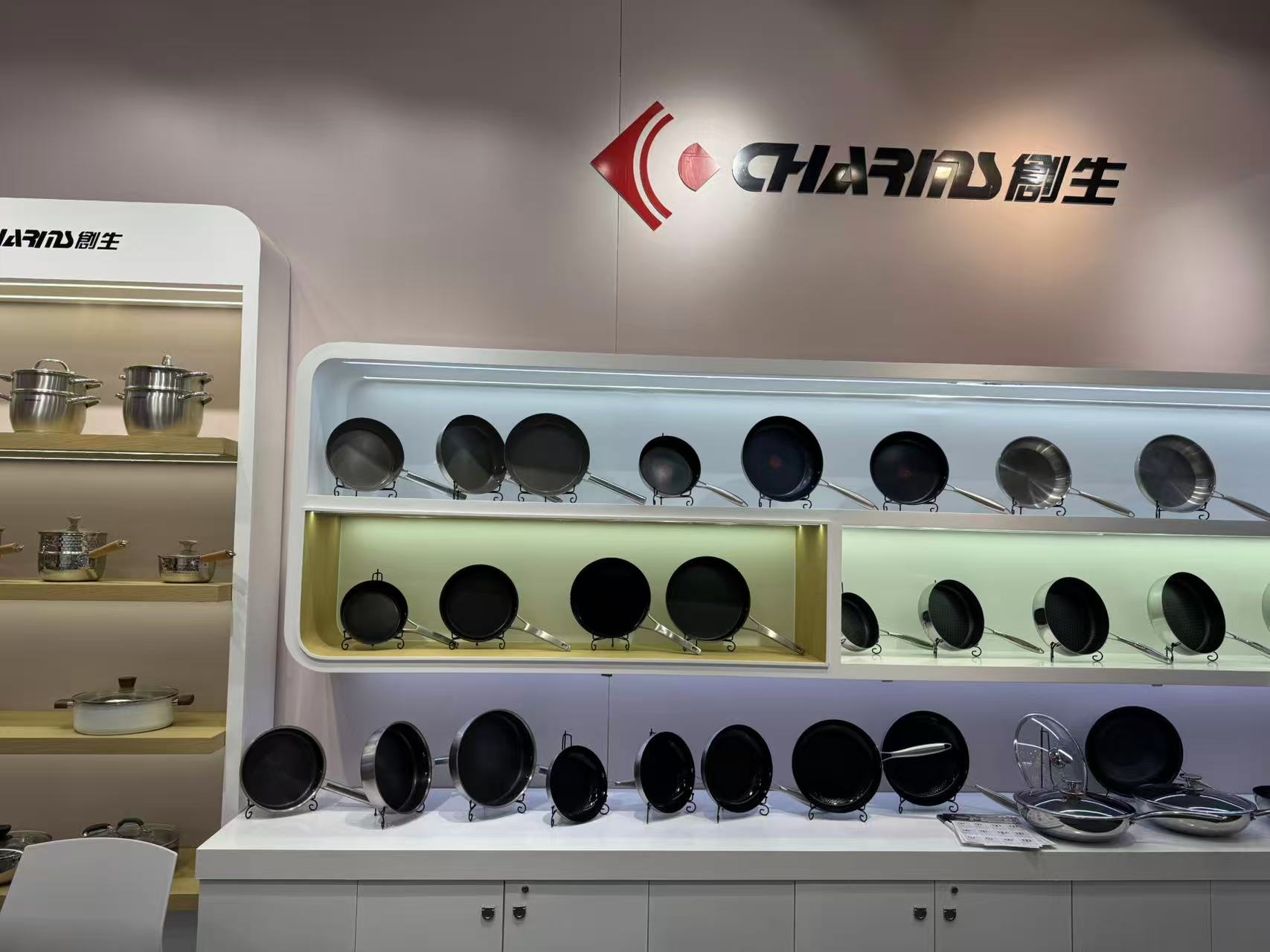As a China-based stainless steel cookware manufacturer, I’ve spent years helping hotel clients, restaurants, and commercial kitchens keep their pots and pans performing at their best. Clean cookware isn’t just about looking good—it affects heat distribution, food safety, lifespan, and your total cost of ownership. This guide draws on our hands-on experience, proven techniques, and the most common questions we get from clients. It’s practical, step-by-step, and ready for you to use right away.
Why Does Proper Stainless Steel Cookware Cleaning Even Matter?
We’ve all heard it: “It’s stainless steel—stain-proof!” Simple to remember, but not the whole story. Stainless steel resists corrosion thanks to a thin, protective layer of chromium oxide (called a “passive film”) on its surface. This layer is tough, but it’s not indestructible. Food scraps, acidic residue, minerals from hard water, or abrasive cleaners can damage this film or let grime stick to the metal. Here’s what happens next:
-
Worse heat transfer (hot spots, uneven cooking)
-
Stubborn stains, rainbow discoloration, or dark marks that look like rust
-
Bacteria growing in burnt food or grease buildup—a major food safety risk
-
More frequent replacements in commercial kitchens are driving up long-term costs
Proper cleaning protects performance, safety, and your reputation. For buyers and specifiers in commercial foodservice or retail, a good maintenance routine is part of getting the most out of your cookware.

What’s the Best Way to Clean Stainless Steel Cookware Daily?
Daily cleaning should be simple, fast, and repeatable—perfect for busy kitchen shifts. Here’s the step-by-step process we recommend (and follow in our own quality control kitchen):
-
Cool it down (gently). Let the cookware cool for a minute or two. Sudden temperature changes (like plunking a hot pot into cold water) can warp thin pans.
-
Empty and rinse. Scrape off food scraps, then rinse under warm water.
-
Clean with a soft pad and mild soap. Use warm water, neutral dish soap, and a non-scratching pad. Wipe gently in circles, following the grain.
-
Don’t forget edges and handles. Use a soft brush or toothbrush for small crevices.
-
Rinse thoroughly. Soap film leaves streaks.
-
Dry right away. Prevents water spots and mineral rings.
-
Store properly. (See the storage section below.)
Why bother with this? It removes food and grease before they carbonize and means you’ll rarely need harsher cleaners later. For kitchens, add this step to your prep/close checklist every time.
How to Clean Stains or Burnt-On Food?
Burnt food and discoloration are the biggest headaches. The right fix depends on how bad the damage is.
Light: Loosen Stuck-On Food Fast
-
Fill the pot with hot water and a squirt of dish soap.
-
Let it soak for 10–20 minutes.
-
Use a soft nylon pad.
-
Rinse and dry.
Great for recent spills and oily gunk.
Medium: Burnt-On Messes (Baking Soda + Boiling Water)
-
Add enough water to cover the burnt area.
-
Bring to a boil and simmer 5–10 minutes.
-
Turn off the heat, stir in 1–2 tablespoons of baking soda.
-
Cool slightly, scrub gently, rinse, and dry.
Heavy: Deep Brown/Black Carbon Buildup
-
Boil water + baking soda; add vinegar afterward for tough stains.
-
Make a baking soda paste and let it sit for 30–60 minutes.
-
If still stubborn, use a non-chlorinated stainless steel cleaner or citric acid soak.
Rainbow Discoloration (Heat Tinting)
-
Mix equal parts vinegar and water, simmer 2–3 minutes, rinse clean.
-
If it lingers, apply baking soda paste and wipe gently.
Mineral Scale/Hard Water Spots
-
Soak in 1:1 vinegar and water for 10–20 minutes, then scrub and rinse.
⚠️ Important Safety Note: Never mix bleach with acids (vinegar, citric acid)—this creates toxic chlorine gas.
What Tools & Cleaners Should You Never Use on Stainless Steel?
Protecting the chromium oxide layer means avoiding mechanical or chemical damage.
Avoid:
-
Steel wool or wire brushes
-
Overusing abrasive powders
-
Direct chlorine bleach
-
Strongly caustic oven cleaners
-
Hydrochloric acid
-
Metal fiber scrub sponges
Safer Alternatives:
Tools: Nylon scrub pads, soft microfiber cloths, soft-bristled brushes, plastic scrapers, and wooden spatulas.
Cleaners: Mild dish soap, baking soda, white vinegar, citric acid, and dedicated non-chlorinated stainless steel cleaners.
Cleaning Methods by Cookware Type (Quick Reference Table)
| Cookware Type | Daily Cleaning | Stain/Burnt Food Removal | What to Avoid | Deep Care Frequency |
|---|---|---|---|---|
| Mirror-Polished Stainless | Warm soapy water, soft cloth, dry immediately | Vinegar soak for mineral spots; baking soda paste for burns | Steel wool, abrasive powders | Monthly polishing + inspection |
| Brushed/Satin-Finished Stainless | Warm water + mild cleaner, scrub with the grain | Baking soda paste; nylon pad | Scratching against the grain | Monthly |
| Multi-Ply (Clad, Aluminum-Core) | Avoid overheating | Simmer water + baking soda | Highly alkaline oven cleaners | Quarterly |
| Induction-Ready Stainless | Vinegar soak for base rings | Boil water + vinegar | Abrasive pads | Monthly |
| Enamel-Coated Stainless | Soft sponge, mild soap | Warm water + baking soda | Metal scrapers, harsh abrasives | Weekly |
| Copper-Bottomed Stainless | Dish soap + soft pad | Copper-safe polish on base | Acidic polishes on stainless steel | Monthly |
| Riveted Handles & Seams | Brush around rivets | Toothbrush + baking soda | Moisture in seams | Weekly |
| Lids (Glass Rim + Stainless) | Clean parts separately | Vinegar for glass stains | Chlorinated cleaners on gaskets | Weekly |
| Powder-Coated/Painted Exteriors | Soft cloth, mild cleaner | Spot clean | Abrasive cleaners or solvents | Monthly |
How to Restore Shine & Brightness to Stainless Steel Cookware?
Restoring shine is both cosmetic and practical—it shows professionalism.
-
Clean first. Follow the daily routine.
-
Wipe gently with a soft cloth (with the grain).
-
Rinse with vinegar to remove film.
-
Use a baking soda paste for dull spots.
-
Apply a non-chlorinated, food-safe stainless steel polish if needed.
-
Optional: Wipe exteriors with food-safe oil for extra luster.
Pro tip: Always polish with the grain—cross-grain rubbing causes scratches.
How to Dry & Store Stainless Steel Cookware Properly After Cleaning?
Drying
-
Wipe dry immediately with a microfiber.
-
Avoid full air-dry if you have hard water.
-
Dry seams, rivets, and lid edges carefully.
Storage
-
Avoid stacking bare steel. Use soft liners between items.
-
Hang larger pots when possible.
-
Store lids separately or upside down.
-
Keep storage dry and ventilated.
-
Separate reactive metals (like cast iron).
-
Inspect weekly for warping or stains.
Conclusion
Properly cleaning stainless steel cookware keeps it performing well, safe to use, and looking professional.
-
Keep daily cleaning simple and repeatable.
-
Use mild cleaners: baking soda, vinegar, neutral soap.
-
Avoid steel wool and harsh chemicals.
-
Restore shine with safe polishes.
-
Set clear SOPs for drying and storage.
-
Train your team—consistent care extends cookware lifespan.
We are a leading stainless steel cookware manufacturer based in China, offering OEM and ODM services for global brands and professional kitchen suppliers.
If you are interested in our products or would like to develop customized cookware solutions, please contact us — we look forward to building a long-term partnership and creating value together.





